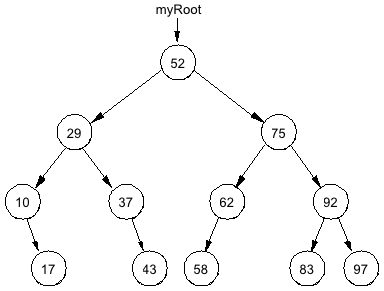-
Deleting a node involves two steps:
- Locating the node to be deleted.
- Eliminating that node from the data structure.
-
After locating the node to be deleted, we must determine the nature of that node.
- If it is a leaf, make the parent node point to
null.
- If it has one child on the right, make the parent node point to the right child.
- If it has one child on the left, make the parent node point to the left child.
- If it has two children, the problem becomes much harder to solve.

Diagram 30-1
-
The leaf node containing the value 43 will be easy to delete. The parent node of the node containing 43 will change its right pointer to null.
Deleting a node with one child on the right, like the node with value 10, will involve rerouting the node from its parent to its single right child.
-
But deleting the node with value 29, a node with two children, involves breaking off subtrees and reattaching them at the proper location.
-
The code to implement deletion from a binary tree is given in Handout AB30.1, Deletion from a Binary Tree. The recursive deleteHelper method that locates the node to be deleted is given below:
public void delete(Comparable target){
myRoot = deleteHelper(myRoot, target);
}
private TreeNode deleteHelper(TreeNode node, Comparable target){
if (node == null) {
throw new NoSuchElementException();
}
else if (target.equals(node.getValue())){
return deleteTargetNode(node);
}
else if (target.compareTo(node.getValue()) < 0)
node.setLeft(deleteHelper(node.getLeft(), target));
return node;
}
else{ //target.compareTo(root.getValue()) > 0
node.setRight(deleteHelper(node.getRight(), target));
return node;
}
}
-
The delete method passes the root of the tree (myRoot) and the target item to be located to the deleteHelper method. The deleteHelper method receives a TreeNode reference alias (node). The deleteHelper method has 4 scenarios:
node == null, the value does not exist in the tree, throw a NoSuchElementException.- We found the correct node (
target.equals(node.getValue())), call deleteTargetNode and pass it node.
- Did not find the node yet, recursively call
deleteHelper and pass it the internal reference to the left child.
- Recursively call
deleteHelper and pass it the internal reference to the right child.


